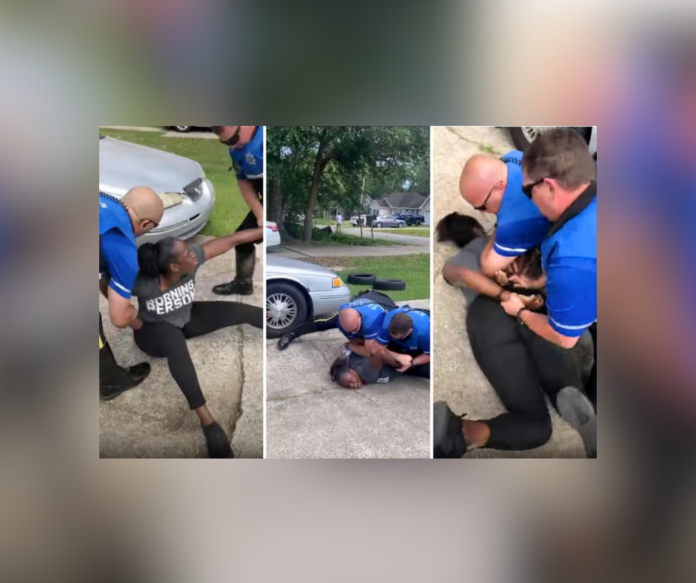A 14-year-old boy fixed the lens of his cell phone on two St. Tammany Parish Sheriff’s deputies in May of 2020 as they wrestled his mother, Teliah Perkins, to the ground. The deputies pinned her face to the driveway of her Slidell home, digging their knees into her back and legs as they handcuffed her.
The encounter began when officers accused Perkins of riding a motorcycle without a helmet, a misdemeanor that carries a $50 fine. It quickly escalated into a physical confrontation when Perkins objected to the officers ordering her son to stay on the porch if he wanted to keep filming. Perkins is Black; both deputies are white.
As they held Perkins on the ground, one of the deputies – Ryan Moring – warned her son to “get back,” and then shoved him several times. When Perkins screamed that she was being choked, Moring stood in front of the boy’s phone so he couldn’t record what was happening, then pointed a Taser at him.
“You can’t tase a child,” said the son, who is referred to as D.J. in court documents.
“Watch me,” the deputy responded.
Despite the threat, the teenager stood his ground and continued to film. That video, and a second recording taken by Perkins’ nephew, formed the basis of a federal civil rights lawsuit filed against the two deputies – Moring and Kyle Hart – in May 2021. The case is now before the Fifth Circuit Court of Appeals.
During oral arguments last month, the circuit court judges focused part of their time on a single question: How much space do officers need to safely perform their official duties without encroaching on a person’s First Amendment rights to observe and record law enforcement?
This same question is at the heart of a debate swirling around a bill proposed in this year’s legislative session. House Bill 85 would require people to stay at least 25 feet away from law enforcement officers – when ordered – while they are engaged in their official duties. Penalties for those who violate the 25-foot buffer include a $500 fine, up to 60 days in jail or both.
It passed the Senate on Monday (June 5) by a vote of 29-10 and is on its way to the desk of Gov. John Bel Edwards for his signature to become law.
State Rep. Mike Johnson, R-Pineville, who authored the bill on behalf of the Louisiana Fraternal Order of Police, said it is intended to create a “safe space” for officers so they can perform their jobs without the fear of being harmed by people who wish to interfere in their investigations. It was not designed to stop people from recording video or audio, he said.
The Perkins case, however, shows how such a law could be abused to accomplish just that, said Nora Ahmed, legal director of the American Civil Liberties Union of Louisiana.
“When you’re talking about the First Amendment right to record, if you turn it into something that’s 25 feet away, what on earth are you going to be able to hear and see?” she said. “It can’t be the standard that every law that is passed is meant to render what law enforcement does less transparent. If we’re a nation of laws, we should be a nation of transparent laws.”

‘Y’all choking a lady’
On the afternoon of May 5, 2020, St. Tammany Parish Sheriff’s deputies Hart and Moring responded to an anonymous complaint about a woman driving a dirt bike without a helmet in the Ozone Woods neighborhood of Slidell.
When they arrived on the scene, deputies said they saw Perkins on a motorcycle without protective headgear and attempted to question her in the driveway of her home. Perkins said that was a lie. She never rode her bike without a helmet and was on her porch, not her motorcycle, when the deputies approached, according to the lawsuit.
Each side accused the other of being belligerent and verbally abusive. Perkins said the deputies harassed her for what was a minor traffic violation because she was Black. The deputies said Perkins ignored their orders and became increasingly irate and disrespectful.
As the situation intensified, Perkins told her son and nephew to come out of the house and record the interaction with their phones. When the deputies warned the boys that they had to stay on the porch if they were going to film, Perkins said it was private property and they could film wherever they wanted, according to court documents and the videos.
That “enraged” the deputies who then informed Perkins she was under arrest, according to the lawsuit.
Perkins’ son was an estimated six feet away from the deputies as he recorded, according to his family’s attorneys. His video shows Hart and Moring force his mother to the ground, twist her arms behind her back, then pin her face to the driveway. The deputies prevent her from moving by digging their elbows and arms into her body.
After about a minute, Moring stood up, told D.J. to “get back,” shoved him several times, then blocked the boy’s phone so he couldn’t record what was happening to his mother. Perkins can be heard screaming, “Why you choking me?” shortly before Moring points his Taser at her son.

A second video taken by the nephew from an unobstructed angle shows Hart bending over Perkins with his arm extended and his hand pressed down on her windpipe as she gasped for air.
“Y’all choking a lady!” the nephew says.
At the end of the 30-minute encounter, deputies booked Perkins into jail on two felonies – resisting a police officer with force or violence and battery of a police officer – and two misdemeanors – no proof of insurance and no safety helmet. After being released from jail, Perkins was treated at Ochsner Medical Center Northshore for injuries to her neck, back, knees, fingers and wrist, according to the lawsuit.
She was later found guilty on a single charge: resisting arrest.
A First Amendment right to record police
Throughout the debate over House Bill 85, opponents expressed concern that by forcing people to stay 25 feet away from officers, it would prevent observers from documenting a problematic arrest involving excessive force. Ahmed and others raised the example of George Floyd whose murder on May 25, 2020 was filmed by a witness from just a few feet away, clearly capturing the scene and audio.
The footage proved instrumental in securing the conviction of former Minneapolis police officer Derek Chauvin as it contradicted the initial account provided by the police department of a routine arrest before Floyd began “suffering medical distress,” without mention of Chauvin keeping his knee on the prone man’s neck for nine minutes. Though Perkins’ case did not result in a fatality, the video her son shot and the proximity from which he shot it was no less important in uncovering the truth, said Ahmed who represents Perkins and her son in their lawsuit against the deputies.
“Had D.J. been forced to be further away, what evidence would there be in this case that anyone would have to look to?” Ahmed said.
After Perkins sued Hart and Moring in the U.S. Eastern District of Louisiana, the deputies filed a motion for summary judgment, asking Judge Wendy Vitter to toss out Perkins’ lawsuit. They argued their use of force was justified due to the actions of Perkins and her son, which caused them to fear for their safety. In addition, the deputies said they should be protected by qualified immunity which shields the police and other public officials from civil liability if their actions didn’t violate clearly established laws or constitutional rights.
Vitter, who was appointed to the federal bench by former President Donald Trump, relied heavily on the boys’ recordings in her July order denying the deputies’ motion. For example, Hart claimed he didn’t choke Perkins and that he only put his hand on her neck to “regain his balance.” But Vitter noted the videos show he put his hands on her neck two separate times. The judge also referenced the audio recording in which Perkins can be heard “shouting that she is in pain” and being “choked.”
“There is sufficient evidence that a jury could determine that the Defendants’ actions during the arrest were disproportionate in comparison to the minor nature of her crimes,” Vitter wrote.
In another example, Moring claimed he only used force against D.J. because the boy slapped his hand and was trying to interfere in his mother’s arrest. Vitter once again pointed to the videos which, she stated, did not show the boy slapping anyone. There is no evidence “D.J. did anything to resist, evade, or interfere with the arrest … beyond filming and standing relatively close.”
Vitter noted that Moring admitted in his deposition that he “intentionally stood” in front of D.J. to block him from recording his mother’s arrest.
“The Fifth Circuit has determined that ‘a First Amendment right to record the police does exist,’” Vitter said in her order, finding evidence that constitutional violations may have occurred.
The extent and circumstances under which citizens can record police is again before the Fifth Circuit as the deputies appealed Vitter’s ruling.
During May 3 oral arguments, the deputies’ attorney, Chadwick Collings, echoed the sentiments of those in favor of creating a legally required “safe space” around law enforcement. He argued that people don’t have the “unfettered right to just walk up to a police officer and start filming them every time and whenever you feel like it.”
“The reality is, that is a very dangerous moment when you have two law enforcement officers on the ground struggling with an individual and you have a family member walking up,” Collings said. “They don’t know if this person’s got a gun, if they’re going to try to join the fight.”
When asked by the court what would be a reasonable distance to ensure an officer’s safety, and where “interference begins and where the First Amendment ends,” Collings offered 21 feet. That is the distance some experts have determined a knife-wielding suspect can cover before officers can draw and fire their weapons, he said, citing the controversial 21-foot-rule.
“In this case, this individual was well within 21 feet,” Collings said, referring to the 14-year-old. “Could he have closed that distance and jumped on the back of one of those officers and started struggling with him for his firearm to try to defend his mother? Absolutely.”
The court concluded oral arguments after about an hour. It has yet to issue a ruling.
The question now hanging in the balance before both the Fifth Circuit and the governor – who has not commented on whether he intends to sign House Bill 85 – is to what lengths the public can be pushed away from police, Ahmed said, before “you ultimately lose your ability to record evidence” that will determine the constitutionality of their actions.
Source: Verite, Author: Richard A. Webster





